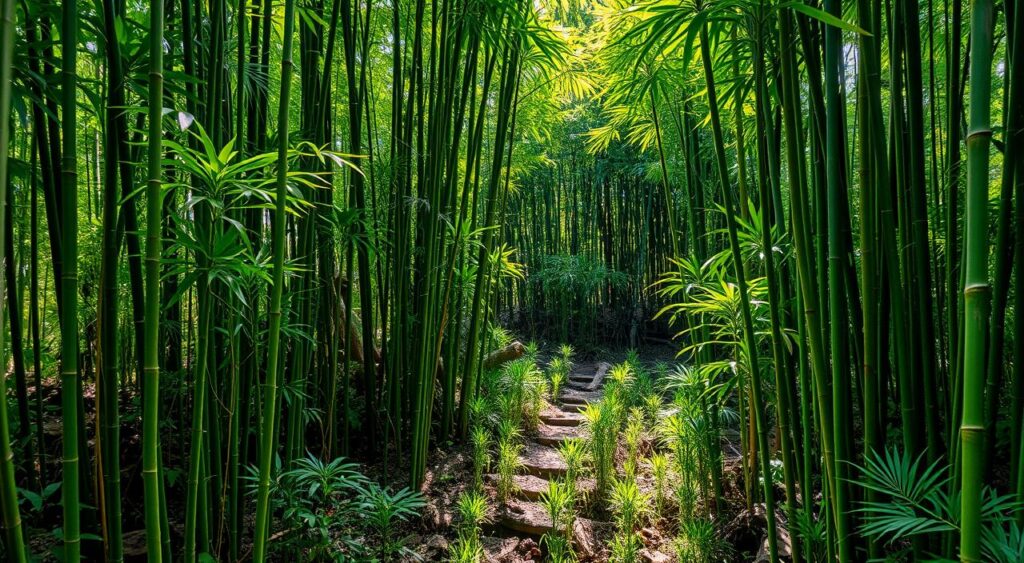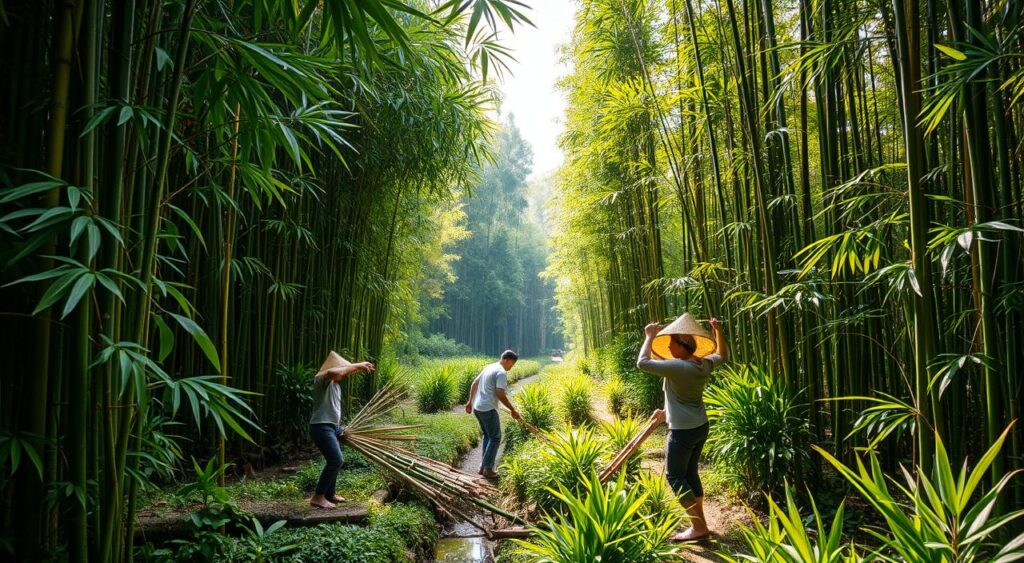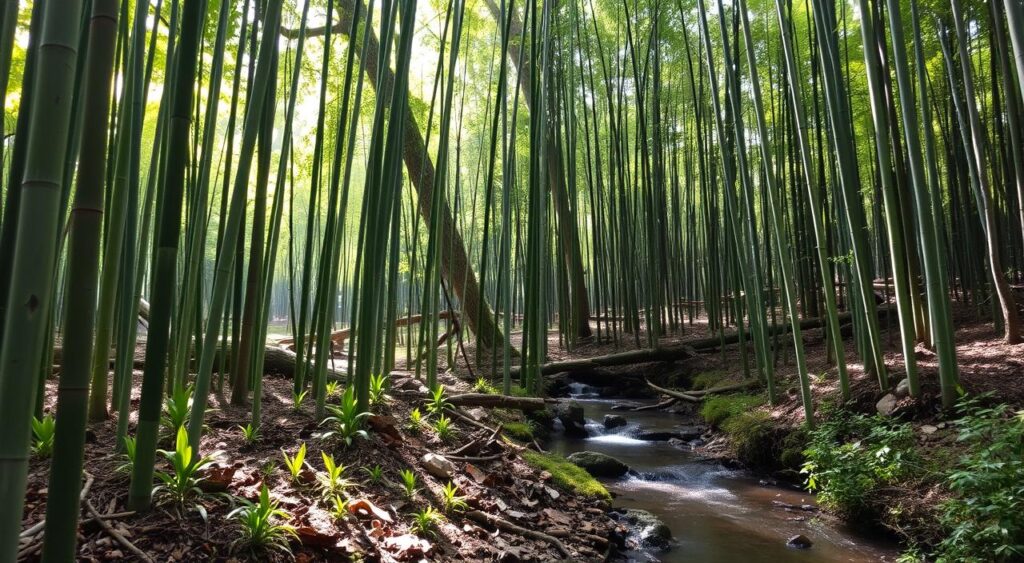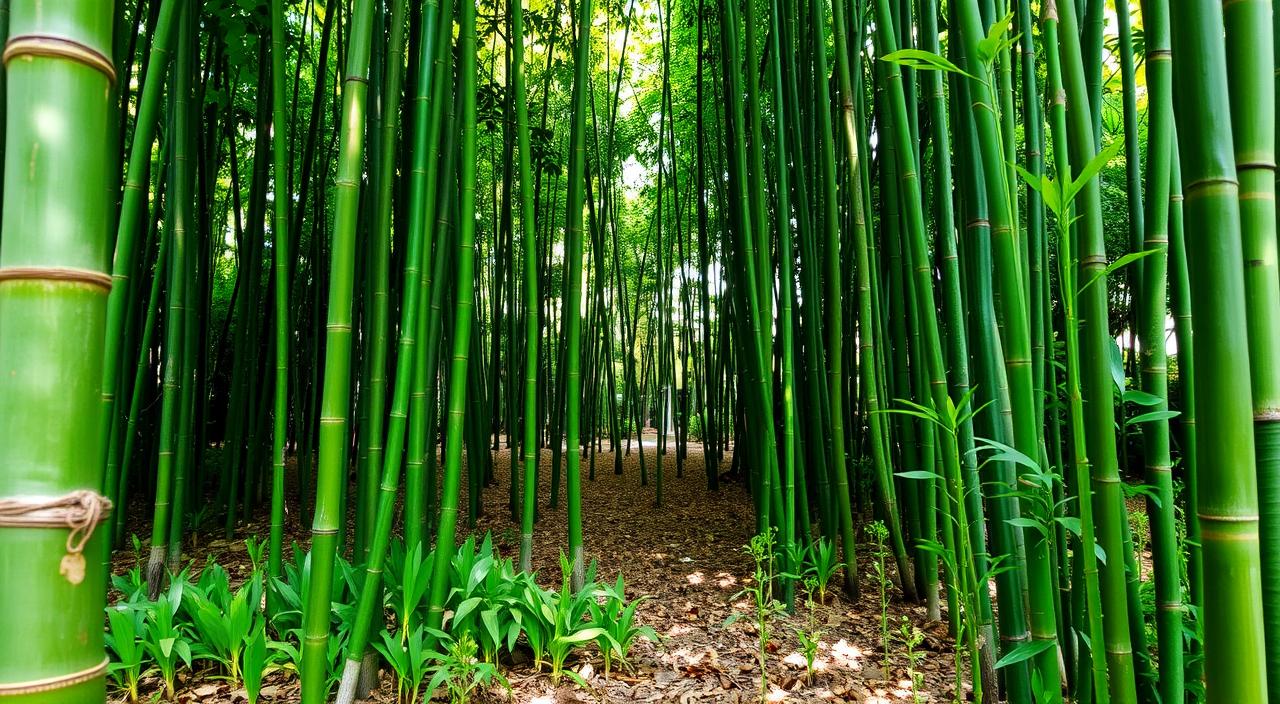Giant pandas are seasonal migrants that mainly eat bamboo shoots and leaves. The quality of these foods is crucial, especially during mating and birthing times. Protecting bamboo shoots is vital for the giant panda’s survival.
This article looks into how bamboo regeneration helps giant pandas. It also talks about the challenges and what needs to be done to save this important process.
Key Takeaways
- Bamboo regeneration is crucial for the survival of the endangered giant panda.
- Factors like elevation, canopy cover, moss thickness, and dead bamboo density significantly impact bamboo seedling density and regeneration.
- Pandas prefer foraging in areas with high bamboo density and biomass, leading to marked declines in bamboo cover.
- Spatial autocorrelation and understanding of panda-bamboo interactions are important for effective conservation efforts.
- Protecting bamboo habitats and ensuring sustainable management are key priorities for giant panda conservation.
Importance of Bamboo Shoots for Giant Panda Reproduction
Bamboo shoots are key for giant pandas’ reproduction. They are a vital food source, especially when pandas are mating and pregnant. Pandas time their breeding with bamboo’s growth to get the most nutrients.
Bamboo Shoots as a Crucial Nutrient Source
In the mating season, from March to May, pandas eat more bamboo shoots. These shoots are packed with protein. This protein is needed for growing babies and for milk production.
Having enough bamboo shoots is crucial for pandas’ success. As seasonal breeders, pandas breed when shoots are most plentiful. This helps their babies grow strong.
| Nutrient | Bamboo Shoots | Bamboo Leaves |
|---|---|---|
| Protein | 4.5-7.2 g/100g | 2.7-4.1 g/100g |
| Carbohydrates | 4.8-7.6 g/100g | 11.1-13.4 g/100g |
| Fiber | 1.4-2.9 g/100g | 8.1-11.8 g/100g |
“The availability of high-quality forage, such as bamboo shoots, significantly contributes to the reproductive success, survival, and growth of giant panda populations.”
Bamboo Regeneration

Optimal Conditions for Bamboo Seedling Regeneration
Bamboo regeneration is key for the survival of giant pandas. Studies found that elevation and canopy cover are important. The best conditions for bamboo seedlings are at middle elevations and under medium to high canopy cover.
Moss thickness, moss cover, and dead bamboo density also matter. More moss and less dead bamboo help seedlings grow. Removing dead bamboo and controlling grazing can speed up regeneration. This benefits the bamboo groves and the giant pandas.
| Factors Influencing Bamboo Seedling Regeneration | Effect on Seedling Density |
|---|---|
| Elevation | Highest at middle elevations (2800-3000 m) |
| Canopy Cover | Highest under medium to medium-high canopy cover |
| Moss Thickness | Increases with increasing moss thickness |
| Moss Cover | Increases with increasing moss cover |
| Dead Bamboo Density | Decreases with increasing dead bamboo density |
The regeneration of bamboo, especially Bashania faberi, Fargesia qinlingensis, Sinarundinaria fangiana, and Fargesia denudata, is vital. It helps keep bamboo groves healthy for giant pandas. Knowing the best conditions for bamboo seedling growth helps conservation efforts.
Threats to Bamboo Shoots: Local Community Harvesting

The bamboo forests in the Liangshan Mountains are crucial for giant pandas. They provide a home and food for these endangered animals. However, local communities also harvest bamboo shoots, which are a favorite of pandas and people alike.
Assessing the Intensity of Bamboo Shoot Harvesting
Researchers did a detailed survey to understand the impact of bamboo shoot harvesting. They looked at how much local communities harvest in areas near panda reserves. The results showed that some places need more protection to keep pandas’ food safe.
The study found that too much harvesting by locals harms pandas. It causes anthropogenic disturbance and leads to fewer pandas. Knowing how bamboo shoots grow and how much are harvested is key. It helps make better management policies and teach locals about giant panda conservation.
Working with local communities is important. Conservationists can teach them to harvest bamboo shoots in a way that helps pandas. This way, both pandas and locals can thrive. It’s a balance needed to save these iconic animals and their homes.
Conservation Priorities for Bamboo Shoot Protection

A recent study on bamboo regeneration has pinpointed key areas for protecting bamboo shoots. These shoots are vital for the giant panda’s survival. The Liangshan, Daxiangling, and Xiaoxiangling regions are most urgent for conservation efforts.
The QiongL-B population, between the Minshan and Qionglai mountains, is also crucial. It could connect isolated panda populations. Protecting bamboo shoots here is essential for the pandas’ genetic diversity and survival.
To tackle local communities’ bamboo harvesting, the study suggests better management policies. It also calls for raising public awareness and offering new income sources. These steps are vital for conservation.
By focusing on these areas and using a comprehensive approach, the study aims to protect the giant panda. It also seeks to preserve the bamboo-dependent ecosystem’s balance moso bamboo is effects of bamboo..
Also Read: The Environmental Impact of Deforestation on Panda Habitats
Conclusion
This study shows how vital bamboo regeneration is for the giant panda’s survival. The decline in bamboo shoots in Volcanoes National Park is a big worry. It affects the pandas’ food, especially when they need it most.
Understanding how to grow bamboo better can help save the pandas. This research can guide conservation efforts. It also shows how to manage bamboo harvesting to help both humans and pandas.
More research and teamwork are needed to protect bamboo and the pandas. Scientists, policymakers, and local people must work together. This way, we can keep the pandas and their bamboo homes safe for the future.
FAQs
Q: How does bamboo regeneration contribute to panda survival?
A: Bamboo regeneration is crucial for panda survival because it provides their primary food source. As bamboo species regenerate, they maintain healthy bamboo stands, ensuring a continuous supply for pandas, especially in forest areas where they inhabit.
Q: What is the significance of guadua bamboo in forest ecology and management?
A: Guadua bamboo is significant in forest ecology and management as it plays a role in stabilizing soil, enhancing biodiversity, and providing habitat for various species, including pandas. Its fast growth and regeneration rates make it an essential component of tropical forest ecosystems.
Q: What effects does bamboo flowering have on panda populations?
A: Bamboo flowering can have dramatic effects on panda populations. When bamboo species flower, they may die off, leading to food shortages for pandas. This can necessitate the migration of pandas to new areas with sufficient bamboo stands for survival.
Q: How does the management of bamboo influence forest regeneration?
A: The management of bamboo can significantly influence forest regeneration. Properly managed bamboo stands can promote biodiversity and facilitate the growth of tree seedlings, while poorly managed bamboo monocultures can hinder tree regeneration and the overall health of the forest ecosystem.
Q: What are the implications of bamboo invasion in temperate forests of Patagonia?
A: Bamboo invasion in the temperate forests of Patagonia can disrupt local ecosystems by outcompeting native species. This can lead to reduced biodiversity and altered forest dynamics, ultimately affecting the regeneration of tree seedlings and the health of the forest.
Q: How does the life cycle of bamboo affect its management in forest ecosystems?
A: The life cycle of bamboo, which includes phases such as flowering, shoot regeneration, and bamboo culm growth, affects its management strategies. Understanding these cycles helps in planning for sustainable bamboo populations and ensuring that the forest ecology remains balanced.
Q: What is the role of understory dwarf bamboo in forest ecology?
A: Understory dwarf bamboo plays a critical role in forest ecology by providing ground cover, stabilizing soil, and serving as a habitat for various wildlife. It can also influence tree regeneration by creating microclimates and protecting young tree seedlings from harsh environmental conditions.
Q: Can bamboo dynamics influence the distribution of other plant species in forests?
A: Yes, bamboo dynamics can greatly influence the distribution of other plant species in forests. The dominance of certain bamboo species can suppress the growth of tree seedlings and other understory plants, thus shaping the overall composition and diversity of the forest ecosystem.
Q: How may the rate of bamboo growth affect local wildlife, including pandas?
A: The rate of bamboo growth can directly impact local wildlife, including pandas. Fast-growing bamboo ensures a stable food supply, while slow growth or die-offs can lead to food shortages, forcing pandas to adapt their foraging behavior or migrate to different areas in search of food.
Q: What are the challenges associated with managing bamboo populations in forest settings?
A: Challenges in managing bamboo populations include preventing bamboo invasion, maintaining biodiversity, and balancing bamboo dominance with the regeneration of tree species. Effective forest ecology and management practices are essential to address these challenges and promote healthy forest ecosystems.

